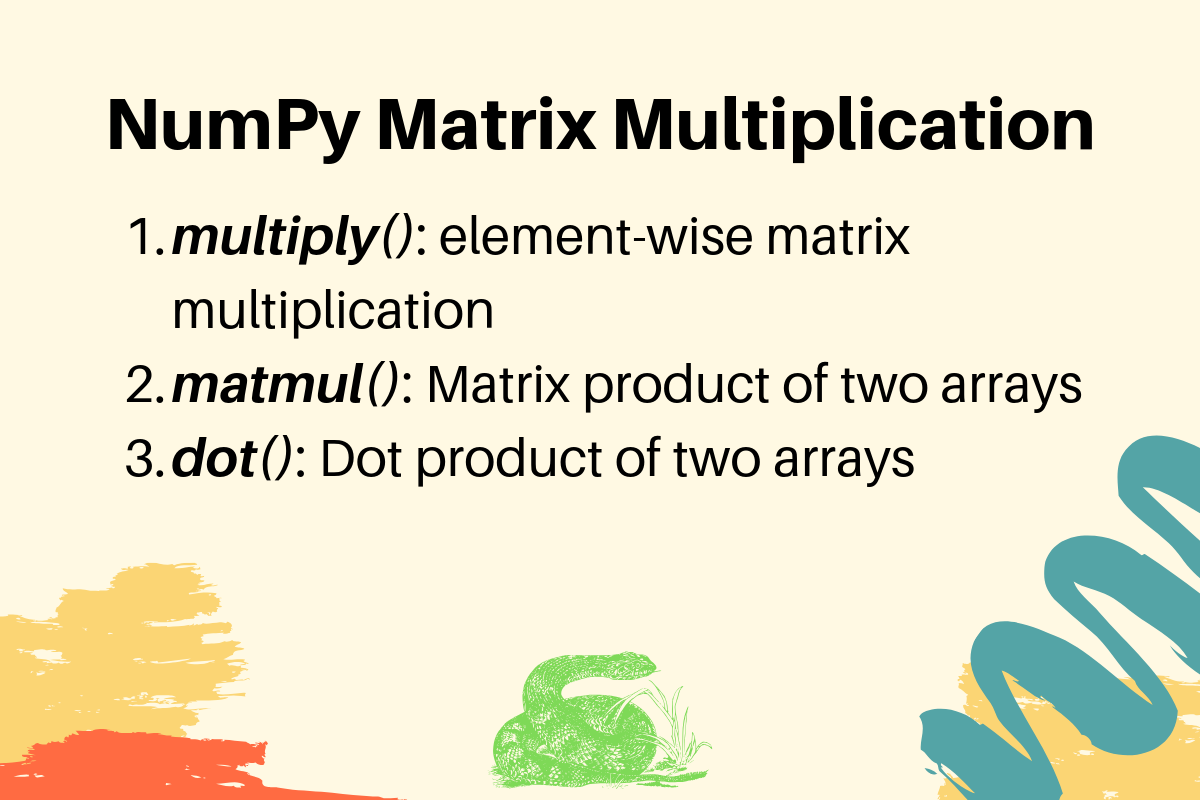- Log in to:
- Community
- DigitalOcean
- Sign up for:
- Community
- DigitalOcean

NumPy matrix multiplication can be done by the following three methods.
- multiply(): element-wise matrix multiplication.
- matmul(): matrix product of two arrays.
- dot(): dot product of two arrays.
1. NumPy Matrix Multiplication Element Wise
If you want element-wise matrix multiplication, you can use multiply() function.
import numpy as np
arr1 = np.array([[1, 2],
[3, 4]])
arr2 = np.array([[5, 6],
[7, 8]])
arr_result = np.multiply(arr1, arr2)
print(arr_result)
Output:
[[ 5 12]
[21 32]]
The below image shows the multiplication operation performed to get the result matrix.

2. Matrix Product of Two NumPy Arrays
If you want the matrix product of two arrays, use matmul() function.
import numpy as np
arr1 = np.array([[1, 2],
[3, 4]])
arr2 = np.array([[5, 6],
[7, 8]])
arr_result = np.matmul(arr1, arr2)
print(f'Matrix Product of arr1 and arr2 is:\n{arr_result}')
arr_result = np.matmul(arr2, arr1)
print(f'Matrix Product of arr2 and arr1 is:\n{arr_result}')
Output:
Matrix Product of arr1 and arr2 is:
[[19 22]
[43 50]]
Matrix Product of arr2 and arr1 is:
[[23 34]
[31 46]]
The below diagram explains the matrix product operations for every index in the result array. For simplicity, take the row from the first array and the column from the second array for each index. Then multiply the corresponding elements and then add them to reach the matrix product value.

The matrix product of two arrays depends on the argument position. So matmul(A, B) might be different from matmul(B, A).
3. Dot Product of Two NumPy Arrays
The numpy dot() function returns the dot product of two arrays. The result is the same as the matmul() function for one-dimensional and two-dimensional arrays.
import numpy as np
arr1 = np.array([[1, 2],
[3, 4]])
arr2 = np.array([[5, 6],
[7, 8]])
arr_result = np.dot(arr1, arr2)
print(f'Dot Product of arr1 and arr2 is:\n{arr_result}')
arr_result = np.dot(arr2, arr1)
print(f'Dot Product of arr2 and arr1 is:\n{arr_result}')
arr_result = np.dot([1, 2], [5, 6])
print(f'Dot Product of two 1-D arrays is:\n{arr_result}')
Output:
Dot Product of arr1 and arr2 is:
[[19 22]
[43 50]]
Dot Product of arr2 and arr1 is:
[[23 34]
[31 46]]
Dot Product of two 1-D arrays is:
17
Recommended Readings:
Thanks for learning with the DigitalOcean Community. Check out our offerings for compute, storage, networking, and managed databases.
About the author
Java and Python Developer for 20+ years, Open Source Enthusiast, Founder of https://www.askpython.com/, https://www.linuxfordevices.com/, and JournalDev.com (acquired by DigitalOcean). Passionate about writing technical articles and sharing knowledge with others. Love Java, Python, Unix and related technologies. Follow my X @PankajWebDev
Still looking for an answer?
- Table of contents
- 1\. NumPy Matrix Multiplication Element Wise
- 2\. Matrix Product of Two NumPy Arrays
- 3\. Dot Product of Two NumPy Arrays
- References
Deploy on DigitalOcean
Click below to sign up for DigitalOcean's virtual machines, Databases, and AIML products.
Become a contributor for community
Get paid to write technical tutorials and select a tech-focused charity to receive a matching donation.
DigitalOcean Documentation
Full documentation for every DigitalOcean product.
Resources for startups and SMBs
The Wave has everything you need to know about building a business, from raising funding to marketing your product.
Get our newsletter
Stay up to date by signing up for DigitalOcean’s Infrastructure as a Newsletter.
New accounts only. By submitting your email you agree to our Privacy Policy
The developer cloud
Scale up as you grow — whether you're running one virtual machine or ten thousand.
Get started for free
Sign up and get $200 in credit for your first 60 days with DigitalOcean.*
*This promotional offer applies to new accounts only.
